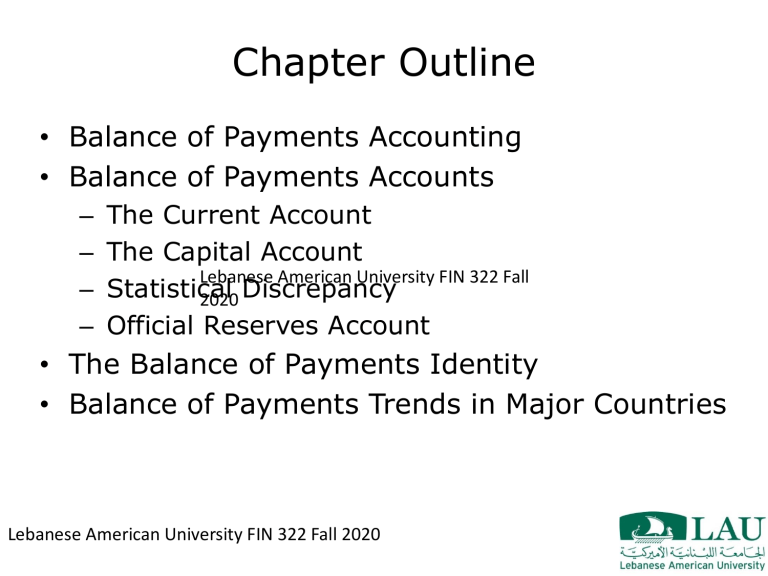
Chapter Outline • Balance of Payments Accounting • Balance of Payments Accounts – – – – The Current Account The Capital Account Lebanese American University FIN 322 Fall Statistical 2020 Discrepancy Official Reserves Account • The Balance of Payments Identity • Balance of Payments Trends in Major Countries Lebanese American University FIN 322 Fall 2020 Balance of Payments Accounting • The balance of payments is the statistical record of a country’s international transactions over a certain period of time presented in the form of double-entry bookkeeping. Note: When we say “a country’s balance of payments” we are referring to the transactions of its citizens and government. Lebanese American University FIN 322 Fall 2020 Balance of Payments Example • Suppose that Maplewood Bicycle in Maplewood, Missouri, USA imports $100,000 worth of bicycle frames from Mercian Bicycles in Darby, England. • There will exist a $100,000 credit recorded by Mercian that offsets a $100,000 debit at Maplewood’s bank account. • This will lead to a rise in the supply of dollars and the demand for British pounds. Lebanese American University FIN 322 Fall 2020 Balance of Payments Accounts • The balance of payments accounts are those that record all transactions between the residents of a country and residents of all foreign nations. • They are composed of the following: – – – – The Current Account The Capital Account The Official Reserves Account Statistical Discrepancy EXHIBIT 3.1 A Summary of the U.S. Balance of Payments for 2015 (in $ billion) The Current Account • Includes all imports and exports of goods and services. • Includes unilateral transfers of foreign aid. • If the debits exceed the credits, then a country is running a trade deficit. • If the credits exceed the debits, then a country is running a trade surplus. Lebanese American University FIN 322 Fall 2020 The Capital Account • The capital account measures the difference between U.S. sales of assets to foreigners and U.S. purchases of foreign assets. • In 2015, the U.S. enjoyed a $188.9 billion capital account surplus—absent of U.S. borrowing from foreigners, this finances the U.S. trade deficit. • The capital account is composed of Foreign Direct Investment (FDI), portfolio investments, and other investments. Statistical Discrepancy (1 of 2) • There are going to be some omissions and misrecorded transactions—so we use a “plug” figure to get things to balance. • Exhibit 3.1 shows a discrepancy of $267.8 billion in 2015. Statistical Discrepancy (2 of 2) The Official Reserves Account • Official reserves assets include gold, foreign currencies, SDRs, and reserve positions in the IMF. The Balance of Payments Identity BCA + BKA + BRA = 0 where BCA = balance on current account BKA = balance on capital account BRA = balance on the reserves account Under a pure flexible exchange rate regime, BCA + BKA = 0 U.S. Balance of Payments Data 2015 (1 of 6) U.S. Balance of Payments Data 2015 (2 of 6) • Balance of Payments: Balance on Current Account – Balance on Current Account: Debit: ($463.0) – In 2015, the U.S. imported more than it exported, thus running a current account deficit of $463.0 billion. • Balance of Payments: Balance on Capital Account – Balance on Capital Account: $188.9 – During the same year, the U.S. attracted net investment of $188.9 billion—clearly the rest of the world found the U.S. to be a good place to invest. U.S. Balance of Payments Data 2015 (3 of 6) • U.S. Balance of Payments “Balance” – Balance on Current Account: Debit: ($463.0) – Balance on Capital Account: Credit: $188.9 – Under a pure flexible exchange rate regime, these numbers would balance each other out. • Balance of Payments Statistical Discrepancy – Statistical Discrepancies: Credit: $267.8 – In the real world, there is a statistical discrepancy. U.S. Balance of Payments Data 2015 (4 of 6) • U.S. Balance of Payments Identity – Including that, the balance of payments identity should hold: – BCA + BKA + SD = – BRA – ($463.0) + $188.9 + $267.8 = ($6.3) U.S. Balance of Payments Data 2015 (5 of 6) • Balance of Payments and the Exchange Rate – Exchange rate $ – As U.S. citizens import, they supply dollars to the FOREX market – As U.S. citizens export, others demand dollars at the FOREX market. U.S. Balance of Payments Data 2015 (6 of 6) Exchange rate $ – As the U.S. government sells dollars, the supply of dollars increases. Sovereign Wealth Funds • Government-controlled investment funds are playing an increasingly visible role in international investments. • SWFs are mostly domiciled in Asian and MidEast countries and usually are responsible for recycling foreign exchange reserves of these countries swelled by trade surpluses and oil revenues. Lebanese American University FIN 322 Fall 2020 Exhibit 3.2: The J-Curve Effect (1 of 2) • Following a currency depreciation, the trade balance may at first deteriorate before it improves. • The shape depends on the elasticity of the imports and exports. Exhibit 3.2: The J-Curve Effect (2 of 2) • As an example, consider an imported good for which there is no domestic producer. If demand is price inelastic, then following a depreciation the trade balance gets worse (until domestic production begins). Lebanese American University FIN 322 Fall 2020 Balance of Payments Trends (1 of 2) • Since 1982 the U.S. has experienced continuous deficits on the current account and continuous surpluses on the capital account. • During the same period, Japan has experienced the opposite. Balance of Payments Trends (2 of 2) • The U.S. and the U.K. tend to realize current account deficits, whereas China, Japan, and Germany tend to realize current account surpluses. • This “global imbalance” implies that the U.S. and U.K. generally use up more outputs than they produce, while the opposite holds for China, Japan, and Germany. Exhibit 3.7: Balance-of-Payments Trends: 1982-2015 Mercantilism and the Balance of Payments • Mercantilism holds that a country should avoid trade deficits at all costs, even to imposing various restrictions on imports. • Mercantilist ideas were criticized in the 18th century by such British thinkers as Adam Smith, David Ricardo, and David Hume. • They argued that the main source of wealth in a country is its productive capacity not its trade surpluses. Lebanese American University FIN 322 Fall 2020 Exhibit 3.8: Top U.S. Trading Partners 2015 (in billions of dollars) Rank Country Imports Exports Trade Balance Total trade 1 China 481.9 116.2 -365.7 598.1 2 Canada 295.2 280.3 -14.9 575.5 3 Mexico 294.7 236.4 -58.4 531.1 4 Japan 131.1 62.5 -68.6 193.6 5 Germany 124.1 49.9 -74.2 174.1 6 Korea, Republic 71.8 43.5 -28.3 115.3 7 United Kingdom 57.8 56.4 -1.5 114.2 8 France 47.6 30.1 -17.6 77.7 9 Taiwan 40.7 25.9 -14.8 66.6 10 India 44.7 21.5 -23.2 66.3 11 Italy 44.0 16.2 -27.8 60.3 12 Brazil 27.4 31.7 4.3 59.1 13 Netherlands 16.8 40.7 24.0 57.5 14 Belgium 19.5 34.1 14.6 53.6 15 Switzerland 31.2 22.3 -8.9 53.5



